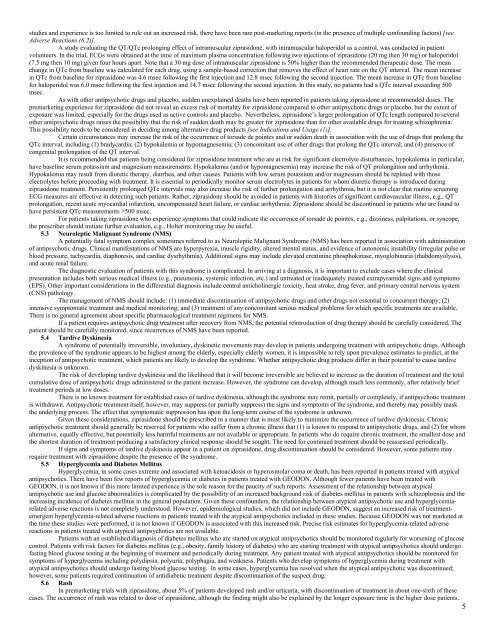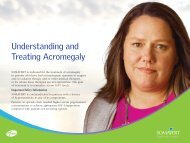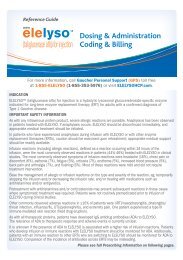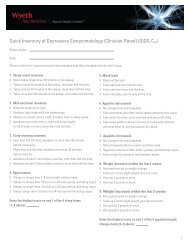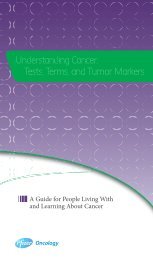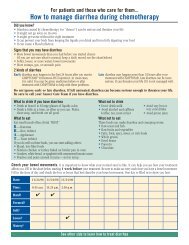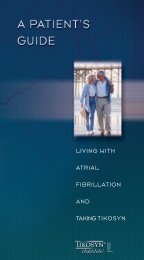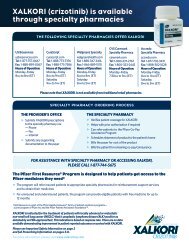GEODON Capsules dosing reference - PfizerPro
GEODON Capsules dosing reference - PfizerPro
GEODON Capsules dosing reference - PfizerPro
You also want an ePaper? Increase the reach of your titles
YUMPU automatically turns print PDFs into web optimized ePapers that Google loves.
studies and experience is too limited to rule out an increased risk, there have been rare post-marketing reports (in the presence of multiple confounding factors) [seeAdverse Reactions (6.2)].A study evaluating the QT/QTc prolonging effect of intramuscular ziprasidone, with intramuscular haloperidol as a control, was conducted in patientvolunteers. In the trial, ECGs were obtained at the time of maximum plasma concentration following two injections of ziprasidone (20 mg then 30 mg) or haloperidol(7.5 mg then 10 mg) given four hours apart. Note that a 30 mg dose of intramuscular ziprasidone is 50% higher than the recommended therapeutic dose. The meanchange in QTc from baseline was calculated for each drug, using a sample-based correction that removes the effect of heart rate on the QT interval. The mean increasein QTc from baseline for ziprasidone was 4.6 msec following the first injection and 12.8 msec following the second injection. The mean increase in QTc from baselinefor haloperidol was 6.0 msec following the first injection and 14.7 msec following the second injection. In this study, no patients had a QTc interval exceeding 500msec.As with other antipsychotic drugs and placebo, sudden unexplained deaths have been reported in patients taking ziprasidone at recommended doses. Thepremarketing experience for ziprasidone did not reveal an excess risk of mortality for ziprasidone compared to other antipsychotic drugs or placebo, but the extent ofexposure was limited, especially for the drugs used as active controls and placebo. Nevertheless, ziprasidone’s larger prolongation of QTc length compared to severalother antipsychotic drugs raises the possibility that the risk of sudden death may be greater for ziprasidone than for other available drugs for treating schizophrenia.This possibility needs to be considered in deciding among alternative drug products [see Indications and Usage (1)].Certain circumstances may increase the risk of the occurrence of torsade de pointes and/or sudden death in association with the use of drugs that prolong theQTc interval, including (1) bradycardia; (2) hypokalemia or hypomagnesemia; (3) concomitant use of other drugs that prolong the QTc interval; and (4) presence ofcongenital prolongation of the QT interval.It is recommended that patients being considered for ziprasidone treatment who are at risk for significant electrolyte disturbances, hypokalemia in particular,have baseline serum potassium and magnesium measurements. Hypokalemia (and/or hypomagnesemia) may increase the risk of QT prolongation and arrhythmia.Hypokalemia may result from diuretic therapy, diarrhea, and other causes. Patients with low serum potassium and/or magnesium should be repleted with thoseelectrolytes before proceeding with treatment. It is essential to periodically monitor serum electrolytes in patients for whom diuretic therapy is introduced duringziprasidone treatment. Persistently prolonged QTc intervals may also increase the risk of further prolongation and arrhythmia, but it is not clear that routine screeningECG measures are effective in detecting such patients. Rather, ziprasidone should be avoided in patients with histories of significant cardiovascular illness, e.g., QTprolongation, recent acute myocardial infarction, uncompensated heart failure, or cardiac arrhythmia. Ziprasidone should be discontinued in patients who are found tohave persistent QTc measurements >500 msec.For patients taking ziprasidone who experience symptoms that could indicate the occurrence of torsade de pointes, e.g., dizziness, palpitations, or syncope,the prescriber should initiate further evaluation, e.g., Holter monitoring may be useful.5.3 Neuroleptic Malignant Syndrome (NMS)A potentially fatal symptom complex sometimes referred to as Neuroleptic Malignant Syndrome (NMS) has been reported in association with administrationof antipsychotic drugs. Clinical manifestations of NMS are hyperpyrexia, muscle rigidity, altered mental status, and evidence of autonomic instability (irregular pulse orblood pressure, tachycardia, diaphoresis, and cardiac dysrhythmia). Additional signs may include elevated creatinine phosphokinase, myoglobinuria (rhabdomyolysis),and acute renal failure.The diagnostic evaluation of patients with this syndrome is complicated. In arriving at a diagnosis, it is important to exclude cases where the clinicalpresentation includes both serious medical illness (e.g., pneumonia, systemic infection, etc.) and untreated or inadequately treated extrapyramidal signs and symptoms(EPS). Other important considerations in the differential diagnosis include central anticholinergic toxicity, heat stroke, drug fever, and primary central nervous system(CNS) pathology.The management of NMS should include: (1) immediate discontinuation of antipsychotic drugs and other drugs not essential to concurrent therapy; (2)intensive symptomatic treatment and medical monitoring; and (3) treatment of any concomitant serious medical problems for which specific treatments are available.There is no general agreement about specific pharmacological treatment regimens for NMS.If a patient requires antipsychotic drug treatment after recovery from NMS, the potential reintroduction of drug therapy should be carefully considered. Thepatient should be carefully monitored, since recurrences of NMS have been reported.5.4 Tardive DyskinesiaA syndrome of potentially irreversible, involuntary, dyskinetic movements may develop in patients undergoing treatment with antipsychotic drugs. Althoughthe prevalence of the syndrome appears to be highest among the elderly, especially elderly women, it is impossible to rely upon prevalence estimates to predict, at theinception of antipsychotic treatment, which patients are likely to develop the syndrome. Whether antipsychotic drug products differ in their potential to cause tardivedyskinesia is unknown.The risk of developing tardive dyskinesia and the likelihood that it will become irreversible are believed to increase as the duration of treatment and the totalcumulative dose of antipsychotic drugs administered to the patient increase. However, the syndrome can develop, although much less commonly, after relatively brieftreatment periods at low doses.There is no known treatment for established cases of tardive dyskinesia, although the syndrome may remit, partially or completely, if antipsychotic treatmentis withdrawn. Antipsychotic treatment itself, however, may suppress (or partially suppress) the signs and symptoms of the syndrome, and thereby may possibly maskthe underlying process. The effect that symptomatic suppression has upon the long-term course of the syndrome is unknown.Given these considerations, ziprasidone should be prescribed in a manner that is most likely to minimize the occurrence of tardive dyskinesia. Chronicantipsychotic treatment should generally be reserved for patients who suffer from a chronic illness that (1) is known to respond to antipsychotic drugs, and (2) for whomalternative, equally effective, but potentially less harmful treatments are not available or appropriate. In patients who do require chronic treatment, the smallest dose andthe shortest duration of treatment producing a satisfactory clinical response should be sought. The need for continued treatment should be reassessed periodically.If signs and symptoms of tardive dyskinesia appear in a patient on ziprasidone, drug discontinuation should be considered. However, some patients mayrequire treatment with ziprasidone despite the presence of the syndrome.5.5 Hyperglycemia and Diabetes MellitusHyperglycemia, in some cases extreme and associated with ketoacidosis or hyperosmolar coma or death, has been reported in patients treated with atypicalantipsychotics. There have been few reports of hyperglycemia or diabetes in patients treated with <strong>GEODON</strong>. Although fewer patients have been treated with<strong>GEODON</strong>, it is not known if this more limited experience is the sole reason for the paucity of such reports. Assessment of the relationship between atypicalantipsychotic use and glucose abnormalities is complicated by the possibility of an increased background risk of diabetes mellitus in patients with schizophrenia and theincreasing incidence of diabetes mellitus in the general population. Given these confounders, the relationship between atypical antipsychotic use and hyperglycemiarelatedadverse reactions is not completely understood. However, epidemiological studies, which did not include <strong>GEODON</strong>, suggest an increased risk of treatmentemergenthyperglycemia-related adverse reactions in patients treated with the atypical antipsychotics included in these studies. Because <strong>GEODON</strong> was not marketed atthe time these studies were performed, it is not known if <strong>GEODON</strong> is associated with this increased risk. Precise risk estimates for hyperglycemia-related adversereactions in patients treated with atypical antipsychotics are not available.Patients with an established diagnosis of diabetes mellitus who are started on atypical antipsychotics should be monitored regularly for worsening of glucosecontrol. Patients with risk factors for diabetes mellitus (e.g., obesity, family history of diabetes) who are starting treatment with atypical antipsychotics should undergofasting blood glucose testing at the beginning of treatment and periodically during treatment. Any patient treated with atypical antipsychotics should be monitored forsymptoms of hyperglycemia including polydipsia, polyuria, polyphagia, and weakness. Patients who develop symptoms of hyperglycemia during treatment withatypical antipsychotics should undergo fasting blood glucose testing. In some cases, hyperglycemia has resolved when the atypical antipsychotic was discontinued;however, some patients required continuation of antidiabetic treatment despite discontinuation of the suspect drug.5.6 RashIn premarketing trials with ziprasidone, about 5% of patients developed rash and/or urticaria, with discontinuation of treatment in about one-sixth of thesecases. The occurrence of rash was related to dose of ziprasidone, although the finding might also be explained by the longer exposure time in the higher dose patients.5


